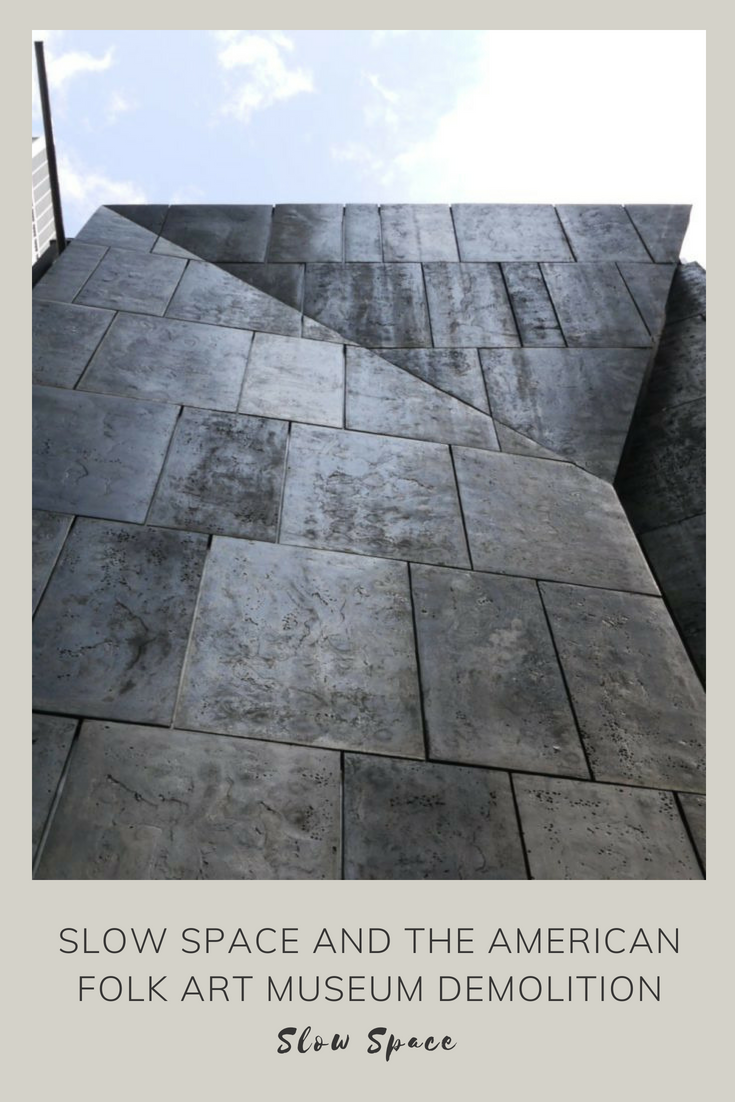In 1999 Architects Tod Williams and Billie Tsien wrote an article entitled “On Slowness” referring to the slow speed of hand drafting, the slow careful thought process of designing and the slow perception and experience of space. They quote Milan Kundera’s novel Slowness and the powerful relationship between time and memory.
“There is a secret bond between slowness and memory, between speed and forgetting. Consider this utterly commonplace situation: A man is walking down the street. At a certain moment, he tries to recall something, but the recollection escapes him. Automatically, he slows down. Meanwhile, a person who wants to forget a disagreeable incident he has just lived through starts unconsciously to speed up his pace, as if he were trying to distance himself from a thing still too close to him in time. In existential mathematics, that experience takes the form of two basic equations: the degree of slowness is directly proportional to the intensity of memory; the degree of speed is directly proportional to the intensity of forgetting.”
They describe how as their work has evolved its essence become more difficult to capture in photographs. The spaces need to be experienced, quietly, slowly, particularly as the buildings relate to the landscape. It is difficult for them to describe their work as well. “So there is no quick take on our work; no singular powerful image that is able to sum it all up.” Perhaps this makes the work more difficult to appreciate in the sound-bite and media driven world we live in.
There is no singular powerful image able to sum it all up.
In 2001 Williams Tsien inaugurated their biggest work to date, the American Folk Art Museum in New York City. Opening to critical acclaim and numerous awards the exquisitely detailed building embodied all of the aspects of slowness that they wrote about. Michael Kimmelman wrote in a New York Times piece “Those bespoke, domestic-size spaces, like the building’s sober hammered bronze facade, share something with the handicraft of the folk art museum’s collection; the building has a rootedness, a materiality, an outsize claim to significance.” The hammered bronze facade even included a panel inscribed with the names of all the workers who helped to build the museum showing their respect to the craftsmen who gave the building their love.
The Folk Art Museum was located on a small site surrounded on three sides by the Museum of Modern Art. Kimmelman writes “It stands proudly on the street, the unfashionable antithesis of generic, open-ended modernism, the opposite of what Diller Scofidio now envisions in its place, with its paradigm of indefinite and perishable culture.” He is referring to the fact that in 2014 the MOMA swallowed up the Folk Art Museum and demolished it to make room for its own never-ending expansion. After only 13 years the building was consumed by fast growth and a gem of Slow Space was lost.
Update: I just learned that so many architects and others were upset by this and the hashtag #folkMOMA was created in protest of the demolition of the Folk Art Museum and the MOMA in general (also Diller, Scofidio & Renfro).
Image: “NYC, 45 West 53rd Street” (CC BY-ND 2.0) by Detlef Schobert








Every once in a while, I spend a day in NYC exploring a particular neighborhood or series of buildings. One of those days was spent patiently taking in the Folk Art Museum, appreciating the path of movement through space, natural light, thoughtful details, and beauty of the objects within. There was a certain intimacy to that experience that will, sadly, be lost forever.
Thankfully, there are other wonderful slow spaces to explore within the hustle & bustle of NYC…the Museum of Chinese in America by Maya Lin, The Noguchi Museum, and Greenacre Park by Sasaki a Associates, to name a few.
Glad you got to experience it Brooke before it was demolished. I love your list of slow spaces in NYC. Thanks for that!
I love that this building emphasizes the connection between the act of making the building to the life of the building and those who experienced it …..